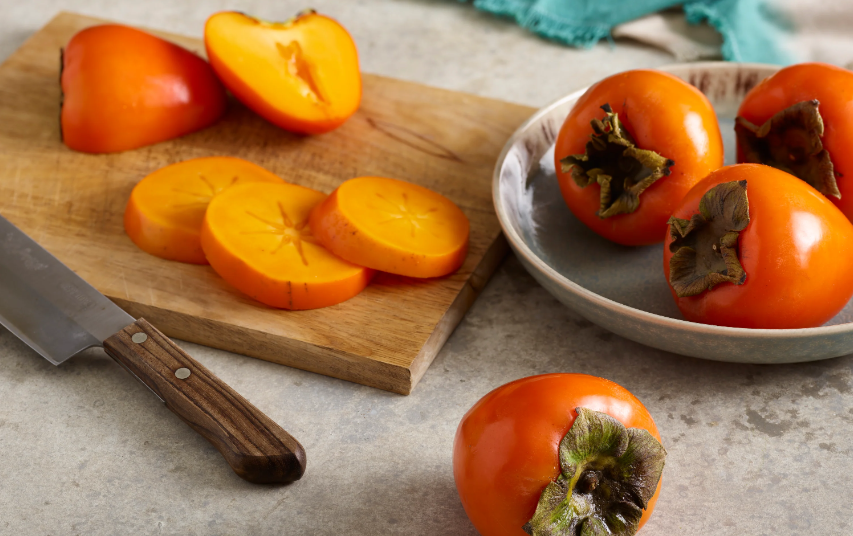
Hachiya persimmons, botanically classified as Diospyros kaki, are ancient fruits that grow on deciduous trees reaching up to 18 meters in height, belonging to the Ebenaceae family. This variety, like many persimmons, has origins in East Asia, particularly in Japan and China.
The tree itself is deciduous, with a somewhat rounded or conical shape. It can grow to about 20-30 feet in height, though it can be pruned to manage its size for easier harvesting or smaller gardens. The leaves are large, glossy, and green, turning to vibrant shades of yellow, orange, or red in the fall.
Hachiya persimmons are acorn-shaped with a pointed end. They have a bright orange skin when ripe, which can sometimes have a deeper red hue. If eaten before it’s fully ripe, the Hachiya persimmon is very astringent due to high levels of soluble tannins, which can make your mouth feel dry and pucker. Once fully ripe, it becomes very sweet, with a jelly-like consistency. The flesh can be so soft that it’s almost like a pudding, which is why they’re often eaten with a spoon.
They must be allowed to ripen fully before consumption. This can be done at room temperature, and the process can be hastened by placing them in a paper bag or with apples or bananas, which produce ethylene gas, aiding in ripening.
Hachiya persimmons are often used in baking, particularly in breads, puddings, and cookies.They are a good source of vitamins A and C, fiber, and antioxidants.
Hachiya persimmons were also introduced to the United States through the USDA in 1870 and were planted in California, Georgia, and Florida. Today Hachiya persimmons are widely grown throughout East Asia in Japan, China, Korea, and Vietnam and are primarily found through fresh markets and local grocers. The fruits are also cultivated in California and are sold through farmer’s markets and specialty grocers as a limited release.
Cultivation
- Climate: These trees thrive in temperate climates. They require a certain amount of chill hours (hours below 45°F or 7°C) to break dormancy, but they also need protection from late frosts which can damage blossoms.
- Soil: Well-draining soil is essential. Persimmons can tolerate a variety of soil types but prefer slightly acidic to neutral pH.
- Watering: Regular watering is necessary, especially in dry periods, but the tree does not like waterlogged conditions.
- Pollination: Hachiya trees are usually not self-pollinating. For the best fruit set, another persimmon tree (which could be another Hachiya or a compatible variety like Fuyu) should be nearby, although some trees might produce seedless fruit without pollination due to parthenocarpy.
Facts and Characteristics
- Appearance: Hachiya persimmons are acorn-shaped with a pointed tip, and when ripe, they have a vibrant orange skin. The flesh inside is a deep orange to almost red when fully ripe.
- Taste and Texture: Unlike the Fuyu or Sharon fruit, Hachiya persimmons are astringent when not fully ripe. They contain high levels of tannins, which make them bitter and astringent if eaten before they are very soft. When ripe, however, they become incredibly sweet, almost syrupy, with a jelly-like texture. The taste can be likened to a blend of honey, dates, and sometimes a hint of spice.
- Usage: Because of their texture when ripe, Hachiya persimmons are often used in recipes where you’d want a liquid or puree, like in smoothies, puddings, ice cream, or baked goods. They can also be dried to make a sweet, chewy fruit similar to dried figs or dates.
- Ripening: Hachiyas must be allowed to fully ripen before eating. This means they should be soft to the touch, almost like a water balloon. You can speed up the ripening process by placing them in a paper bag with an apple or banana, which releases ethylene gas, or by freezing them for a few hours and then thawing.
- Nutritional Value: They are high in vitamins A and C, fiber, and antioxidants. The high tannin content when unripe contributes to their astringency but also has antioxidant properties. Once ripe, they’re a good source of dietary fiber, which aids in digestion.
- Cultivation: Hachiya trees are deciduous and require a climate with a distinct winter chill but not extreme cold. They are often grown in regions with Mediterranean-like climates, similar to other persimmons. The trees can grow quite large, so they might not be ideal for small gardens unless pruned regularly.
- Harvest Season: Typically harvested in the fall, from late October through November or December, depending on the region.
- Storage: Hachiyas can be stored at room temperature to ripen or in the refrigerator to slow down the ripening process. Once ripe, they should be consumed quickly or used in recipes as they can become overripe very fast.